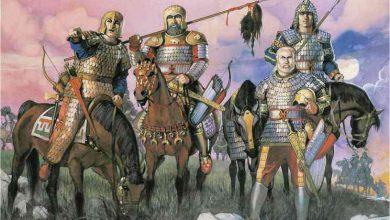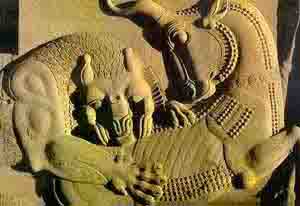Niloofar flower pattern in ancient Iran
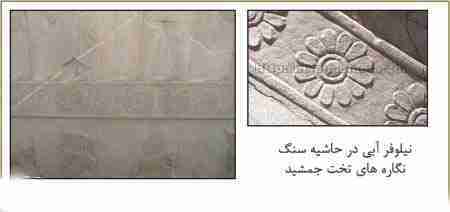
Lilies Take that at all points Persepolis Sculpted, can be A symbol of Achaemenid civilization knew.
This flower, which is seen in most pictures in the hands of the king and the elders, is a symbol of peace and friendship.. It can be said that this flower shows the kindness and peace of Iranians. It is said that the 12 petals of this flower represent the 12 months of the year. The culture level of each nation has a direct relationship with their interest and use of flowers. The many pictures of flowers in Takht Jamshid, in addition to showing the fragrance and beauty of this place, is a proof of the high level of Iranian culture at that time..
Go to the next article to download the book "Niloufer flower in the history of Iran".
…
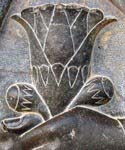
In the culture and civilization of Iran, the lotus flower is a symbol of peace, purity and friendship, and not only this flower but all other flowers can be seen all over Persepolis, and this shows that this type of flower and other flowers are planted in this place. It was common and this is a proof of the rich culture of Iran at that time .
If we assume that this decoration ( It means lotus flower) It is a pure imitation of Egyptian art, so what justification do we have for the cow animal?
As we know, according to the opinion of ancient Iran and Zoroastrians, the cow is the first animal created by Ahura Mazda, and they considered it the embodiment of goodness and blessing, and it was the subject of special respect among all other animals. . On the other hand, in Egypt, the cow has had a special place and they have given it a special status and dignity even to the point of worship, which is an example of the Apis cow, which was considered a gift from heaven. .

On the other hand, cattle are extremely important in India and in Spain .
Isn't it more correct that instead of always talking about imitation art, we should mention an art that belongs to this land and has existed since the past? and these common elements are also among the beliefs and visions of Iranian and Egyptian cultures, not imitation of each other's manifestations .
In Persepolis, different types of decorations are used, each of which is considered a hyacinth and a sign, among these decorations are various types of flowers, some of which can be seen in the hands of the nobles and the king. .
Of course, these many flowers and leaves with many shapes can also be seen in most parts of Persepolis, which are mostly used as borders..
Among these types of flowers, the lotus flower, which has always been considered an imitation of Egyptian art due to its great similarity, but here it should be remembered that different types of flowers can be seen in the decorations of Persepolis, and of course there are opinions about symbolic flowers as well. There have been countless offers, and it is even possible that these flowers were originally objects that were used as perfume bottles or something similar. .
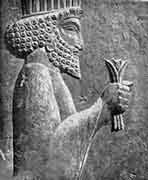
Another point that is necessary and necessary to mention is that some elements are considered part of the beliefs, culture and customs of a nation, and these elements may play the same role that they played in another nation, like this lotus flower. .
If we accept that the lotus flower was popular in Egyptian culture and entered Iranian culture, then what other explanation do we have about the other different flowers that are seen?
Isn't it the fact that these cases have always been described as pure imitation in the art of Persepolis and they have always wanted to bring the art of Persepolis under the influence of the art of other nations?
Of course, in another comment, they don't consider these shapes to be flowers, but due to the finding of the Benz object that looks like these flowers, it is possible that they are perfume bottles or something similar. .
One of the other problems in the review The art of Iran, the land It is quite evident that various archaeologists who have come to Iran for study, research and exploration have studied the art of Mesopotamian and Vivnan Egypt from the beginning, and when they came to Iran, they considered everything as an imitation of the same example in the architecture of the country. The mentioned nations have been mentioned, of course, this work is not out of two situations :
or it was intentional and they were so delighted with the beauty of this art and saw their architecture as inferior to Iranian art that they used this method which always considered Iranian art under the sphere and a subset of the art of other nations. or that it was really accidental and unintentional ..
Of course, it is more correct to accept the first case, and if archaeologists had discovered Iranian art before Greek, Egyptian, and Mesopotamia, the situation would certainly have been different..
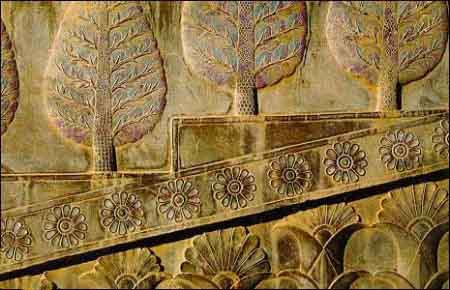
Among the other things that archaeologists have always relied on are figures, statues, decorative materials, ornaments, tools, etc.. which was made and paid for by other nations and was mentioned in Persepolis and they considered it as a proof of pure imitation of all Iranian art in Persepolis .
While we all know and the written inscriptions also indicate that at that time 23 different nations paid ransom to Iran and different countries were under Iran's rule, and this is also written in the form of sculptures in the Upadana Hall. and it has been shaped and these items were originally gifts and offerings that were sent to the court of Iran by the representatives of the same nations and kept in the treasury .
Achaemenid secondary arts such as silversmithing, enameling, goldsmithing, inlaying, casting, weaving carpets and fabrics, and inlaid work were at the peak of perfection and were exported to distant places as precious gifts. .
A clear example of this can be considered the Pazyryk carpet, which was found in the southern part of Siberia. This carpet was woven in Iran and was given as a gift to Shah Sakaei. .
It is necessary to mention Michael Roof's speech about the sculptures of Persepolis :
"The stonemasons of Persepolis, from whatever nationality they were, had no freedom to be innovative in their work. They only executed exactly what was planned by the designers and they usually followed those plans. It cannot tell us the nationality of the artisans who carved it, something some scholars have suggested, but instead it sheds light on the background of the designer. .
The research conducted on the main motifs carved in Persepolis shows that the motifs were borrowed from many artistic traditions, the most important of which were the prominent motifs of the early Achaemenid era in Susa, Pasargad and Biston, and What is equally important is the influence of Mesopotamian, Babylonian and Assyrian art. It seems that Egyptian, Greek, Phoenician, Elamite, Madi, Urartian and Scythian art had a direct or indirect effect on the creation of Persepolis style. Is .
Even if we could specify precisely, we would still have to ask why some topics were accepted and others rejected. Mudgart Roth has recently commented that this selection of a conscious program of political propaganda by The Shah of Iran has been adopted and portrays.
Click on the image below to download the book "Gol Nilofar" in the history of Iran




